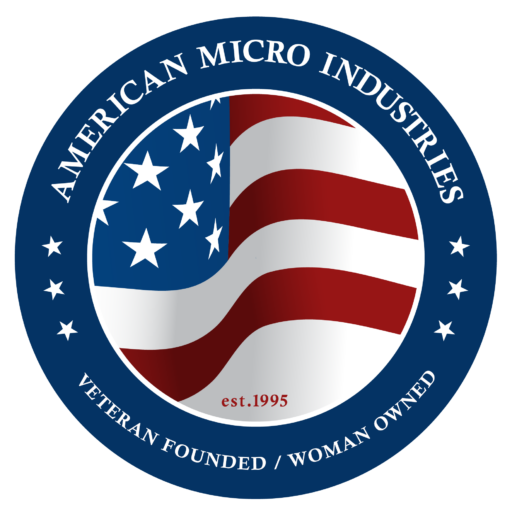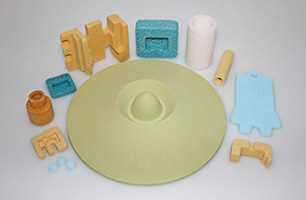


For over 25 years, we’ve provided customers across a broad range of industries with custom fabrication services through computer-aided design (CAD) and computer numerical control (CNC) milling. We are your one-stop shop for manufacturing hard-to-find parts and replacements.
Rigid foam insulation has the highest insulating values of any conventional foam insulation commercially available today. Very low conductivity gases trapped in the closed cellular structure reduce heat transfer by conduction. The combination of these properties yields a material that can be used in service between –100° F to 200° F. Rigid foam board insulation is moisture resistant, dimensionally stable, air tight, resistant to the transfer of heat through and has the ability to perform a structural role.
Polymer-based foam is important in the manufacturing industry. This rigid closed-cell foam is used to produce products in numerous markets, including marine industries and aerospace applications.
There is no one way to cut rigid foam. Rather, many techniques vary in accuracy and efficiency. Despite its bulky structure and dense materials, rigid foam insulation is relatively easy to cut with the right resources. Some basic machinable foam cutting tools include:
Whichever tool you choose, sharpen the side of your blade before using a spring clamp to secure the board to your spirit level. Next, use a straightedge to guide the blade across the foam board for an even cut.
There are three primary rigid foam types — expanded polystyrene (EPS), extruded polystyrene (XPS) and polyisocyanurate. These structural foams each have their own qualities, characteristics and benefits when it comes to product manufacturing.
EPS is the most versatile rigid foam type and can be manufactured in various densities, with high-density EPS comprising exceptional compressive strength. Though this semipermeable material has a higher water absorption capacity and better R-value per dollar than XPS and polyisocyanurate, it is the least expensive of the three. EPS is commonly used in walls, roofs and flooring.
XPS is a rigid foam material with a smooth plastic surface. This insulation type boasts excellent moisture resistance and thermal insulation capabilities. XPS has a higher R-value than polyisocyanurate and is also recyclable, making it a sustainable option for eco-friendly building or retrofitting projects. It is often used to insulate slabs and walls in below-grade waterproofing applications.
Polyisocyanurate is sprayed as a liquid foam that eventually hardens into a rigid panel. This material features a foil facing for heightened durability and impermeability. It has greater ignition resistance than EPS and XPS but is the most expensive foam of the three. Because polyisocyanurate has a high R-value, it doesn’t perform as well as other insulation types, especially in lower temperatures. It’s popular for use in roofing applications.
We offer three types of RF and microwave foam — shielding foam, absorbing foam and low loss dielectric foam.
Shielding foam is a type of rigid foam that absorbs sound, radar, radio and microwaves. The purpose of foam absorbers is to soak up, defect and disperse any of these absorbed waves, preventing them from infiltrating the structure. You can also use shielding foam absorbers as a structural foam. We offer a shielding foam called Eccoshield®. This insulation brand is well-equipped to take on any RF and microwave shielding applications and is available in many options, including caulking, adhesives, conductive sheets and coatings.
Our complete line of RF absorbing foam contains products engineered for various RF applications, including:
Using the magnetically loaded rubber sheet or liquid castable absorbers, you can quiet an RF cavity’s quality factor (Q factor) for better noise performance. We also carry radar-absorbing materials (RAM), which are known for consistent, high-quality performance.
Our Eccosorb® absorbing foam line has various materials optimized for RF and microwave absorbing applications. Eccosorb foams are available in multiple materials and densities. Because they are space-rated polymers, these absorbing foams are commonly used in the aerospace industry.
Low loss dielectric foam is a type of high-temperature rigid foam with a low loss factor. It is easily machinable to close tolerances and is commonly used in antennas, insulators, radar equipment and numerous support pieces. Our low loss foams are especially useful in microwave and RF applications.
We carry a low loss dielectric foam called C-Stock®, a lightweight, rigid foam used for antennas, transmission lines, dielectric spacers and transformers. We also offer our Eccostock® line, featuring everything from rigid and syntactic to flexible foams.
Among our high-density foam materials, sign foam is the most popular. Sign foam is a rigid closed-cell material made of high-density urethane foam commonly used for carving applications such as signs and billboards. Rigid sign board is an excellent choice for both indoor and outdoor use — it is completely resistant to water and other solvents and impervious to extreme temperatures, snow, rain and ice. For this reason, many customers who purchase sign foam use it to create weatherproof outdoor signs and advertisements.
Polyvinyl (PVC) foam is a material that features durable properties, such as high-bending stiffness, weight and strength. PVC foam also reduces acoustic noise. These impressive characteristics promote increased structural efficiency, making this type of foam perfect for constructing vital objects such as naval ships and space shuttles. PVC foam’s sandwich core material also means it’s useful in the marine industry.
Our rigid PVC foam material options include:
American Micro Industries also carries a polyisocyanurate foam called Trymer®. This rigid foam has higher insulation values than any other conventional foam insulation available on the commercial market today. Our Trymer® products trap low-conductivity gases in their closed-cell structure while reducing heat transfer through conduction. These features account for the foam’s increased thermal efficiency.
Trymer® is moisture-resistant with a box-like structure that forms during polystyrene insulation production. It is available in an array of compressive strengths and densities to serve applications requiring stable composites within a range of -297 degrees to over 300 degrees Fahrenheit.
We offer rigid urethane foam, a cross-linked polyurethane material with an R-value higher than any other available foam. This foam is mainly used for thermal insulation purposes.
Polystrene is a thermoplastic polymer foam you can expand or extrude depending on its processing. It is widely used in the packaging industry.
We offer three types of polystyrene foam:
At American Micro Industries, we have specialized tools and project engineers that help us create custom foam machining solutions for our customers. We use the most advanced CNC milling methods to ensure all foam products are structurally sound and retain their thermal and mechanical properties.
In addition to our CNC prototype capabilities, we also offer die cutting services where we cut rigid foam using rotary, steel rule and laser die cutting techniques for the best results.
When you choose American Micro Industries for foam manufacturing, we help you select the most efficient solutions that best fit your individualized product and budgeting needs. You can even submit your own mechanical drawings, and we will transform them into a finished foam product that is constructed to your exact specifications.
If you’re looking for rigid foam solutions optimized for any industry, trust American Micro Industries. We have the innovative technologies and insulated foam materials needed to produce the highest quality products for your business.
To learn more about our services, give us a call at 1-866-774-9353 or fill out an online form today.